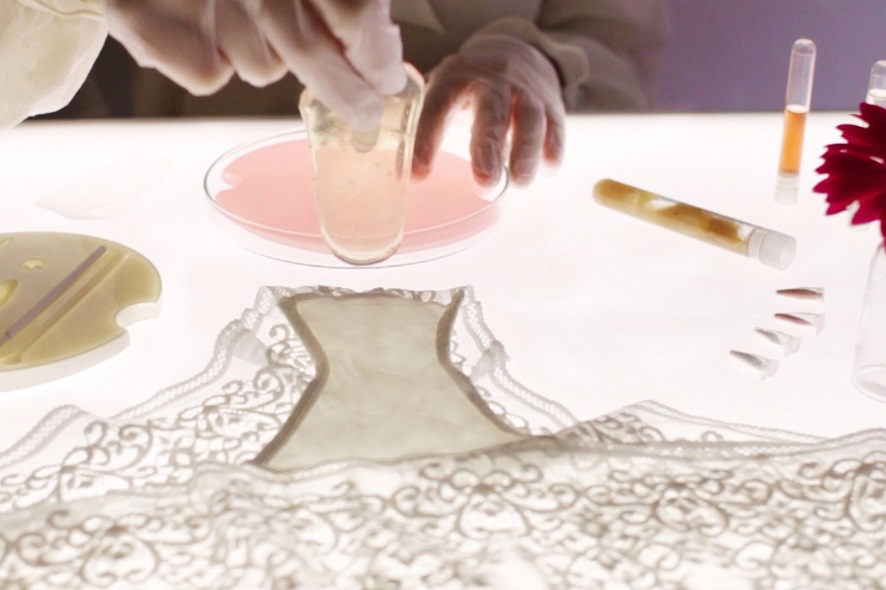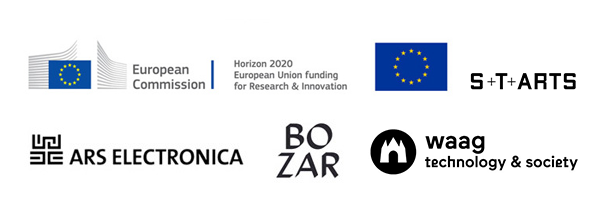With “Future Flora: Celebrating Female Biophilia”, the Do-It-Yourself harvest set for home use, designer and biohacker Giulia Tomasello enables women to grow and use bacteria for their own vaginal flora. This year, she won the STARTS Prize in the category “Artistic Exploration”, an award from the European Commission for outstanding works of art that significantly change the use, development and perception of technology. Incidentally, this is the exact intersection for which the acronym STARTS stands – Science, Technology and the Arts.
“Future Flora” will be on view at the 2018 Ars Electronica Festival at the STARTS exhibition, and Giulia Tomasello will also be talking about her work at the theme conference on Friday, September 7, 2018. In this interview, the designer spoke to us about why she works with vaginal flora bacteria, why biohacking and citizen science are important and what her work means for women’s self-empowerment.
How did you get the idea of creating the Future Flora project? What was the trigger?
Giulia Tomasello: Like many lovers and amateurs in biotechnology and innovation, I started to dive into biology and biohacking while growing living organisms in my room. Then my obsession on wearing second skin and understanding the female behavior, developed with a project strictly connected to both topics. Future Flora is addressed to females that are taking control of their own bodies as a new precious and intimate practice of self‑care. As designer my aim is to raise awareness towards female social taboos, providing an alternative to our intimate treatment by nurturing the living organisms that balance the body equilibrium of our vaginal flora. Many women already, are crossing the boundary between biology and self‑medication, impelled by the strong desire of taking more responsibility to their own health. Practicing vaginal seeding and the use of yoghurt tampon, show how much progress has been made in understanding the role of the microbiome in healthcare and wellbeing, and how much remains to be discovered.

Credit: Giulia Tomasello
Could you please explain us how women can use this harvesting kit? What are the different steps?
Giulia Tomasello: Future Flora is a harvesting kit designed to treat and prevent vaginal infections. The project tackles the experience of growing and nurturing living organisms at home, enabling the female to become a participant in the culture and knowledge of science. The kit is composed by an inoculation loop, a spreader, a pipette with freeze‑dried bacterial compound and the nutrient agar‑agar recipe, plus an instruction leaflet providing the necessary steps to grow and harvest your own pad at home. The included tools are now considered basic laboratory equipment. The bacterial pad grows the necessary strings of Lactobacillus bacteria to create a hostile environment for the further development of Candida Albicans, acting as living culture of probiotics. By placing the pad in contact with the female genitalia, the healthy bacteria grow on the surface of the infected area, reconstructing the microflora missing in the vagina epithelium. Considering that 75% of women suffer from Candida vulvovaginitis (CVV) at least once in their lifetime, Future Flora explores women’s approach in the context of personal self‑care and body awareness, generating an intimate and delicate interaction between the action of nurturing bacteria while they grow, and then wear them as a second layer of your panties.
With your Future Flora project, you are calling on women to take care of their own health at home ‑ why is citizen science so important to you?
Giulia Tomasello: Future Flora proposes alternatives to embrace biological remedies in our home, challenging the values and beliefs that our society embodied in the material culture. The intention behind Future Flora, is to design a tool that will educate and enable women to take up a more active role in their healthcare, prompting them to seek medical advice as necessary and ultimately break some of the taboos associated with urogynaecology health. In this project I examine the possibility of using scientific tools as part of our everyday life, becoming quotidian as a makeup kit. This receptiveness to science is a trend manifested by the growing of bio‑hackerspaces, citizen science and DIY biology. Nevertheless, Future Flora aims not to engineer nature but to design with existing resources. This is an important step to empower citizens with scientific knowledge on the edge of the biohacking revolution, where the female becomes a participant in the culture and the knowledge of science. Celebrating a Female Biophilia opens the possibility of wearing microorganisms in the future, and to embrace them as part of our natural well‑being. Taking care of her own health, the woman becomes a citizen scientist, establishing a first relation with her body and what is part of her living surrounding. Clothes and accessories become the ecosystem that balance the entire skin microflora.

Credit: Giulia Tomasello
What reactions have you received from women? It is, after all, a subject that is still not entirely openly discussed.
Giulia Tomasello: Today society has an expectation for the look, work position, more pressure than any other time in history, aesthetic that needs to be perfect. Having a conversation with your body and understand the silent language is a challenge. We are a society that hides symptoms instead of finding solutions. We live in a culture of silence that surrounds the all topic of female sexual healthcare. The more society talks about female taboos, the more the subject gets easy to understand and recently women have turned on to the internet for answers. The need of speaking about their own bodies and intimate health became urgent, as well involving more women to talk about such sensitive topics. In general, women tend to keep these problems inside. With Future Flora, the iteration itself of making the living culture pad, introduce the user in the unknown place of a laboratory, aiming to identify her curiosity in becoming a participant in the citizen science. It engages the woman in the process of understanding the value of her body and the feedback that the body is constantly sending to her.
As designer my aim is to raise awareness towards female social taboos, providing an alternative to our intimate treatment by nurturing the living organisms that balance the body equilibrium of our vaginal flora. Considering women as both oppressed and free from society, Simone De Beauvoir argues that a woman is not determined by her hormones or by mysterious instincts, but by the manner in which her body and her relation to the world are modified through the action of others than herself.
You are talking about that clothes and accessories will become the ecosystem that balance our skin microflora ‑ what happens next with the project?
Giulia Tomasello: I consider myself a Female Designer, that designs for women, by breaking female taboos to provoke conversations. My aim is to challenge futuristic and social related visions in the field of Biodesign, by merging the knowledge of science and design to raise critical awareness. Developing new propositions for the society and for the future of women’s healthcare by introducing a female biophilia’s approach. Currently I am working on different projects which are women’s healthcare and wellbeing based. There I continue to develop innovative tools in the intersection of medical and social sciences, by using materiality to question and communicate the boundaries between technology and our bodies.

Giulia Tomasello (IT), born in 1990, is an interaction designer and researcher specializing in wearables, biotechnology, and material finishes. She is currently Research Assistant in Interactive Wearables at Nottingham Trent University. In the past two years she has been investigating the potential of biotechnology and living materials, proposing a biological and sustainable alternative for electronic textiles. She considers herself a maker and explorer, using materiality to question and communicate the boundaries between technology and our bodies. By designing alternative scenarios and acting as a creative thinker, Giulia questions our notions of wellbeing to develop innovative tools in the intersection of medical and social sciences. These intersections are enabled by her multidisciplinary collaborations and the symbiosis between her creative and scientific work, generating knowledge exchange and social integrations in healthcare.
Interview conducted by Martin Hieslmair, Ars Electronica.
With her project Future Flora, Giulia Tomasello won this year’s STARTS Prize in the category Artistic Exploration. The work will be on view at the 2018 Ars Electronica Festival from September 6 to 10 at the STARTS exhibition at POSTCITY Linz. Tomasello will also speak about her project at the theme conference on Friday, September 7, 2018, starting from 12:20 PM; and at the Future Sessions: Trust in Invisible Agents on Thursday, September 6, 2018, from 1:30 PM to 4:30 PM.
This project has received funding from the European Union’s Horizon 2020 research and innovation programme under grant agreement No 732019. This publication (communication) reflects the views only of the author, and the European Commission cannot be held responsible for any use which may be made of the information contained therein.

To learn more about Ars Electronica, follow us on Facebook, Twitter, Instagram et al., subscribe to our newsletter, and check us out online at https://ars.electronica.art/news/en/.
